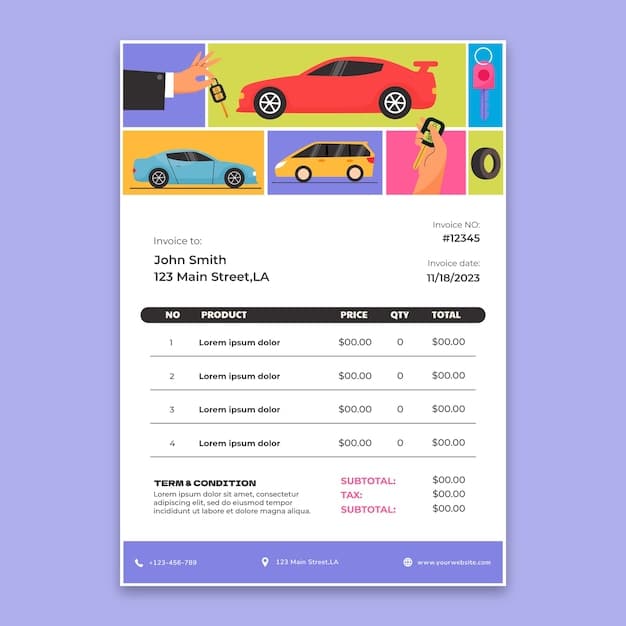2025 Car Buying: MSRP vs. Invoice Price vs. Market Value

Understanding the differences between MSRP, invoice price, and market value is crucial for making informed car buying decisions in 2025, helping you negotiate effectively and secure the best possible deal.
Navigating the world of car buying can feel like deciphering a secret code. Understanding the key pricing terms is vital for a successful purchase. Let’s demystify the 2025 car buying: understanding the differences between MSRP, invoice price, and market value to empower your negotiations.
Understanding the Manufacturer’s Suggested Retail Price (MSRP)
The Manufacturer’s Suggested Retail Price, or MSRP, is the automaker’s recommended selling price. It’s displayed on the car’s window sticker (Monroney sticker) and is often the starting point for negotiations, but it’s rarely the final price.
What Does MSRP Include?
The MSRP typically includes the base price of the vehicle, manufacturer-installed options, and the destination charge (the cost of shipping the car to the dealership).
What MSRP Doesn’t Include?
MSRP doesn’t include state and local taxes, title and registration fees, or dealer-added options and markups. These factors can significantly impact the final price you pay for the car.
- MSRP is a suggestion, not a fixed price.
- Negotiating down from MSRP is a common practice.
- Dealer add-ons are separate and negotiable.
Understanding what the MSRP represents, and what it doesn’t, is the first step in getting a fair price on your new vehicle. Remember to research the car’s features and options to determine if the MSRP accurately reflects its value.
Decoding the Invoice Price
The invoice price represents what the dealership paid the manufacturer for the vehicle. It’s tempting to think you can get the car for this price, but dealerships need to make a profit.
What is Hidden in the Invoice Price?
Many assume the price is exactly how much a dealer paid for the car, but this isn’t always the case.
Dealer Incentives
They are incentives like volume bonuses a dealer receives for selling lots of cars, therefore they won’t always sell at invoice price.
How to Use the Invoice Price in Negotiations
While you likely won’t get the car for the invoice price, knowing it gives you leverage. Aim to negotiate a price that’s above invoice but below MSRP.

- Use invoice price as a benchmark.
- Be realistic about the dealer’s need to profit.
- Combine invoice price knowledge with other negotiation tactics.
The invoice price is a valuable piece of information, but it’s just one factor in the car buying process. Use it strategically, along with other research and negotiation skills, to get the best possible deal.
Navigating Market Value in 2025
Market value reflects what buyers are actually paying for a particular car in your area. It’s influenced by supply and demand, regional preferences, and current economic conditions.
How to Determine Market Value
Online resources like Kelley Blue Book (KBB) and Edmunds can provide estimates of the market value for specific vehicles. These tools consider factors like location, trim level, and condition.
The Impact of Supply and Demand
In 2025, the car market is still navigating the aftereffects of supply chain disruptions and increased demand for certain models. This can lead to higher market values, especially for popular or hard-to-find vehicles.

- Check multiple sources for market value estimates.
- Be aware of regional price differences.
- Factor in the current supply and demand situation.
Understanding market value is essential for setting realistic price expectations and avoiding overpaying for a car. Remember to adjust your expectations based on the specific vehicle you’re interested in and the local market conditions.
The Art of Car Negotiation: A 2025 Guide
Negotiation is a crucial part of the car buying process. By understanding MSRP, invoice price, and market value, you can approach negotiations with confidence and increase your chances of getting a good deal.
Research is Key
Before you step into a dealership, research the MSRP, invoice price, and market value of the car you want.
Be Prepared to Walk Away
Dealers want to make a sale. If they see you are willing to walk away, they will often try to come closer to your price to land the deal.
Tips for Successful Car Negotiations
Start by making a reasonable offer based on your research. Be polite but firm, and don’t be afraid to counteroffer. Be prepared to walk away if the dealer isn’t willing to meet your needs.
- Start with a fair offer based on research.
- Focus on the final price, not just the monthly payment.
- Be willing to walk away to show you’re serious.
Negotiation is a skill that improves with practice. The more you understand the pricing structure and the car market, the better equipped you’ll be to negotiate effectively.
Financing and Incentives in 2025
Financing and incentives can significantly impact the overall cost of buying a car. Understanding your financing options and taking advantage of available incentives can save you money.
Exploring Financing Options
Consider your loan options to see whats available for the current auto market.
Manufacturer Incentives
Several incentives may be available, these can be loyalty deals, military discounts, and more, it is best to always be on the lookout.
Tips for Securing the Best Financing and Incentives
Shop around for the best interest rates and loan terms. Check for manufacturer incentives, such as rebates or low-interest financing. Be sure to read the fine print and understand all the terms and conditions.
- Compare financing options from different lenders.
- Inquire about available manufacturer incentives.
- Understand the terms and conditions of your loan and incentives.
Financing and incentives are important aspects of the car buying process. By doing your homework and exploring your options, you can potentially save thousands of dollars.
The Future of Car Buying: Trends to Watch in 2025
The car buying landscape is constantly evolving. In 2025, several trends are reshaping the way people shop for and purchase vehicles.
The Rise of Online Car Buying
Online car buying platforms can provide a convenient and transparent way to shop for cars, compare prices, and even complete the entire purchase process online.
The Growing Popularity of Electric Vehicles (EVs)
EVs are becoming increasingly popular. Consider if an Electric Vehicle fits your needs when getting a car.
Staying Ahead of the Curve
Keep an eye on emerging technologies, such as augmented reality and virtual reality, which are starting to enhance the car buying experience. Stay informed about changes in government regulations and incentives related to electric vehicles and other green technologies.
- Embrace online car buying platforms.
- Consider the benefits of EVs.
- Stay informed about emerging technologies and regulations.
The future of car buying is dynamic and exciting. Embrace new technologies and stay informed about industry trends to make the most of your car buying experience.
| Key Aspect | Brief Description |
|---|---|
| 💰 MSRP | Manufacturer’s suggested retail price; often negotiable. |
| 🧾 Invoice Price | What the dealer paid; a starting point for negotiation. |
| 📈 Market Value | What buyers are currently paying; influenced by supply and demand. |
| 🤝 Negotiation | Research, be prepared to walk away, and know your budget. |
Frequently Asked Questions
▼
The end of the month, quarter, or year is often a good time, as dealers may be trying to meet sales quotas. Weekdays are typically less busy, allowing for more focused attention.
▼
A larger down payment reduces your loan amount and monthly payments, potentially saving you money on interest. Aim for at least 10% of the car’s price, if possible.
▼
Trading in can be convenient, but get an independent appraisal first to ensure you’re getting a fair offer. Selling privately might yield more but requires more effort.
▼
Dealer-added options and markups are often negotiable. Destination charges and government fees are usually non-negotiable. Always ask for a detailed breakdown of all fees.
▼
Leasing typically results in lower monthly payments but you don’t own the car. Buying builds equity but can have higher initial costs. Consider your budget and long-term needs.
Conclusion
Understanding MSRP, invoice price, and market value empowers you to navigate the 2025 car buying process with confidence. By researching your options, negotiating effectively, and staying informed about industry trends, you can secure the best possible deal and drive away in the car of your dreams.





